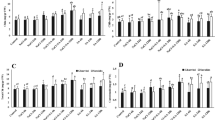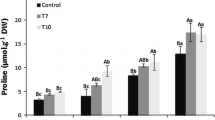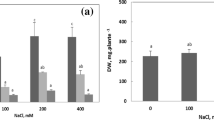Abstract
The objective of the present study was to assess the role of salinity-induced expression of pyrrolline 5-carboxylate synthetase (P5CS), P5CS activity, and proline accumulation on salinity tolerance in Brassica genotypes. A pot culture experiment was conducted with four Brassica genotypes viz. CS 52, CS 54, Varuna, (B. juncea) and T 9 (B. campestris) under control and two salinity levels, i.e., 1.65, 4.50 and 6.76 dS m−1. Proline contents increased with increasing levels of salinity, and the highest content were recorded at post-flowering stage in CS 52 and CS 54. Activity of P5CS recorded at flowering stage was highest at higher level of salinity, with CS 52 and CS 54 recording highest activity. Gene expression of P5CS, which regulates the synthesis of proline, was higher in CS 52 and CS 54 under salt stress than Varuna and T 9. Comparison of partial nucleotide as well as amino acid sequence showed conserved domains, and inter and intra generic relatedness of these genes. The study suggests that salinity-induced expression of P5CS, pyrrolline-phosphate synthetase activity and proline accumulation may serve as one of the mechanism of salinity stress tolerance in Brassica genotypes.





Similar content being viewed by others
Abbreviations
- ECe:
-
Electrical conductivity of extract
- MSI:
-
Membrane stability index
- P5CS:
-
Pyrrolline 5-carboxylae synthetase
- RWC:
-
Relative water content
References
Ahmad P (2009) Growth and antioxidant responses in mustard (Brassica juncea L.) plants subjected to combined effect of gibberellic acid and salinity. Arch Agron Soil Sci 56:575–588
Altschul SR, Madden TL, Schaffer AA, Zhang Z, Zhang J, Miller W, Lipman DJ (1997) Gapped BLAST and PSI-BLAST: a new generation of protein database search programmes. Nucleic Acids Res 25:3389–3402
Ashraf MY, Waheed RA, Bhatti AS, Baig A, Aslam Z (1999) Salt tolerance potential in different Brassica species: growth studies. In: Harndy A, Lieth H, Todorovic M, Moscheu M (eds) Halophyte use in different climates II. Backhuy Pubs, Leiden, pp 119–125
Bates LS, Waldren RP, Teare ID (1973) Rapid determination of free proline for water-stress studies. Plant Soil 39:205–207
Bohnert HJ, Jensen RG (1996) Strategies for engineering water stress tolerance in plants. Trend Biotech 14:89–97
Chakraborty K, Sairam RK, Bhattacharya RC (2012) Differential expression of salt overly sensitive pathway genes determines salinity stress tolerance in Brassica genotypes. Plant Physiol Biochem 51:90–101
Chinnusamy V, Jagendorf A, Zhu JK (2005) Understanding and improving salt tolerance in plants. Crop Sci 45:437–448
Cochran WG, Cox GM (1957) Experimental designs, 2nd edn. John Willey & Sons Inc., New York
Dong J, Bowra S, Vincze E (2010) The development and evaluation of single cell suspension from wheat and barley as a model system; a first step towards functional genomics application. BMC Plant Biol 10:239–250
Garcia-Rios M, Fujita T, LaRosa PC, Locy RD, Clithero JM, Bressan RA, Csonka LN (1997) Cloning of a polycistronic cDNA from tomato encoding γ-glutamyl kinase and γ-glutamyl phosphate reductase. Proc Natl Acad Sci USA 94:8249–8254
Gilbert GA, Gadush MV, Wilson GC, Madore MA (1998) Amino acids accumulation on sink and source tissues of Coleus blumei Benth during salinity stress. J Exp Bot 49:107–114
Girija C, Smith BN, Swamy PM (2002) Interactive effects of NaCl and CaCl2 on the accumulation of proline and glycinebetaine in peanut (Arachis hypogaea L.). Environ Exp Bot 47:1–10
Goudarzi M, Pakniyat H (2009) Salinity causes increase in proline and protein contents and peroxidase activity in wheat cultivars. J Appl Sci 9:348–353
Hmida-Sayari A, Gargouri-Bouzid R, Bidani A, Jaoua L, Savoure A, Jaoua S (2005) Overexpression of Δ1-pyrroline-5-carboxylate synthetase increases proline production and confers salt tolerance in transgenic potato plants. Plant Sci 169:746–752
Handique GK, Handique AK (2009) Proline accumulation in lemongrass (Cymbopogon flexuosus Stapf.) due to heavy metal stress. J Environ Biol 30:299–302
Hong Z, Lakkineni K, Zhang Z, Verma DPS (2000) Removal of feedback inhibition of Δ 1-pyrroline-5-carboxylate synthetase results in increased proline accumulation and protection of plants from osmotic stress. Plant Physiol 122:1129–1136
Hura J, Jung KH, Lee CH, Ana G (2004) Stress-inducible OsP5CS2 gene is essential for salt and cold tolerance in rice. Plant Sci 167:417–426
Khan MA, Shirazi MU, Khan MA, Mujtaba SM, Islam E, Mumtaz S, Shereen A, Ansari RU, Ashraf MY (2009) Role of proline, K/Na ratio and chlorophyll content in salt tolerance of wheat (Triticum aestivum L.). Pak J Bot 41:633–638
Kholová J, Sairam RK, Meena RC, Srivastava GC (2009) Response of maize genotypes to salinity stress in relation to osmolytes and metal-ions contents, oxidative stress and antioxidant enzymes activity. Biol Plant 53:249–256
Madan S, Nainawatte HS, Jain RK, Choudhury JB (1995) Proline and proline metabolizing enzymes in in-vitro NaCl tolerant Brassica juncea under salt stress. Ann Bot 76:51–57
Martínez-Atienza J, Jiang X, Garciadeblas B, Mendoza I, Zhu JK, Pardo JM, Quintero FJ (2007) Conservation of the salt overly sensitive pathway in rice. Plant Physiol 143:1001–1012
Mohammadkhani N, Heidari R (2008) Drought-induced accumulation of soluble sugars and proline in two maize varieties. World Appl Sci J 3:448–453
Munns R, James RA, Lauchi A (2006) Approaches to increasing salt tolerance in wheat and other cereals. J Exp Bot 57:1025
Nuccio ML, Rhode D, McNeil SD, Hanson AD (1999) Metabolic engineering of plants for osmotic stress resistance. Curr Opin Plant Biol 2:128–134
Parida AK, Dagaonkar VS, Phalak MS, Aurangabadkar LP (2008) Differential responses of the enzymes involved in proline biosynthesis and degradation in drought tolerant and sensitive cotton genotypes during drought stress and recovery. Acta Physiol Plant 30:619–627
Sairam RK, Rao KV, Srivastava GC (2002) Differential response of wheat genotypes to long-term salinity stress in relation to oxidative stress, antioxidant activity and osmolyte concentration. Plant Sci 163:1037–1046
Sairam RK, Srivastava GC, Agarwal S, Meena RC (2005) Differences in antioxidant activity in response to salinity stress in tolerant and susceptible wheat genotypes. Biol Plant 49(1):85–91
Siddiqui ZS, Khan MA, Kim BJ, Huang JS, Kwon TR (2008) Physiological responses of Brassica genotypes to combined drought and salt stress. Plant Stress 2:78–83
Silva-Ortega CO, Ochoa-Alfaro AE, Reyes-Agüero JA, Aguado-Santacruz GA, Jime′nez-Bremont JF (2008) Salt stress increases the expression of P5CS gene and induces proline accumulation in cactus pear. Plant Physiol Biochem 46:82–92
Siripornadulsil S, Traina S, Verma DPS, Richard T, Sayre RT (2002) Molecular mechanisms of proline-mediated tolerance to toxic heavy metals in transgenic microalgae. Plant Cell 14:2837–2847
Song SQ, Lei YB, Tian XR (2005) Proline metabolism and cross-tolerance to salinity and heat stress in germinating wheat seeds. Russ J Plant Physiol 52:793–800
Sumithra K, Jutur PP, Carmel BD, Reddy AR (2006) Salinity-induced changes in two cultivars of Vigna radiata: responses of antioxidative and proline metabolism. Plant Growth Regul 50:11–22
Thomas H (1997) Drought resistance in plants. In: Basra AS, Basra RK (eds) Mechanisms of environmental stress resistance in plants. Harwood Academic Publishers, Amsterdam, pp 1–42
Yamada M, Morishita H, Urano K, Shiozaki N, Yamaguchi-Shinozaki K, Shinozaki K, Yoshiba Y (2005) Effects of free proline accumulation in petunias under drought stress. J Exp Bot 56:1975–1981
Yancey PH (2005) Organic osmolytes as compatible, metabolic and counteracting cytoprotectants in high osmolarity and other stresses. J Exp Biol 208:2819–2830
Zhu X, Gong H, Chen G, Wang S, Zhang C (2005) Different solute levels in two spring wheat cultivars induced by progressive field water stress at different developmental stages. J Arid Environ 62:1–14
Acknowledgments
K. Chakraborty gratefully acknowledges the Council of Scientific and Industrial Research, New Delhi, India for the award of senior research fellowship during the course of the study.
Author information
Authors and Affiliations
Corresponding author
Additional information
Communicated by M. Stobiecki.
Rights and permissions
About this article
Cite this article
Chakraborty, K., Sairam, R.K. & Bhattacharya, R.C. Salinity-induced expression of pyrrolline-5-carboxylate synthetase determine salinity tolerance in Brassica spp. Acta Physiol Plant 34, 1935–1941 (2012). https://doi.org/10.1007/s11738-012-0994-y
Received:
Revised:
Accepted:
Published:
Issue Date:
DOI: https://doi.org/10.1007/s11738-012-0994-y




